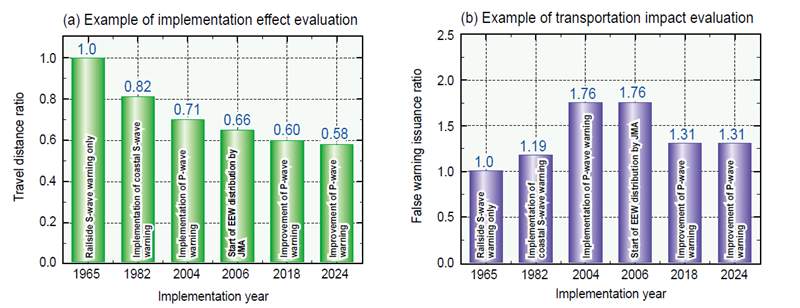1. Performance Evaluation Method for Earthquake Early Warning Systems
When a new warning method is implemented an earthquake early warning (EEW) system, faster warning issuance to enhance safety can be expected. On the other hand, the increased frequency of warning issuance may have an impact on stable transportation. Therefore, when implementing a new warning method to a railway under consideration, it is necessary to quantitatively assess both its implementation effects and its transportation impacts in advance.
We developed a performance evaluation method for earthquake early warning systems, using two indicators: the travel distance ratio, which quantifies the implementation effects based on the time difference between the initial warning issuance and the arrival of strong earthquake ground motion (representing the relative change in travel distance until running-train suspension after warning issuance), and the false warning issuance ratio, which assesses the transportation impacts based on the number of earthquake detection sites that issued warnings (representing the relative change in unnecessary warning issuances). As a tool for this evaluation, we developed a simulator for operation control after an earthquake (Figure 1).
To validate the performance evaluation method and the simulator for operation control after an earthquake, we conducted simulations using past earthquake records, comparing conventional warning methods for a virtual railway and earthquake detection sites. As a result, we confirmed that the implementation effects and transportation impacts of each method can be quantitatively compared (Figure 2). This enables quantitative evaluation of performance improvements in earthquake early warning systems prior to implementing a new earthquake early warning. This performance evaluation method can be used to support decision-making when implementing a new warning method into an earthquake early warning system.
Other Contents
- 1. Performance Evaluation Method for Earthquake Early Warning Systems
- 2. Method for Setting Regulation Values for Operation Control Under Rainfall Using Radar Rain Gauges
- 3. Method for Estimating Track Buckling Risk Based on On-board Measurements
- 4. Method for Identifying Wheel Usage Limit Temperature and Evaluating Safety While in Service
- 5. Investigation of Front Rod Fracture Causes and Maintenance Methods to Prevent Fracture
- 6. Detection System for DC High-resistance Ground Faults by Utilizing the Current Data of Both Substations and Vehicles
- 7. Forward Obstacle Detection System for Trains in Preparation for Future Driverless Operation
- 8. Validation of the Long-term Effectiveness of Automatic Deerdeterrent Sound Devices
- 1. Performance Evaluation Method for Earthquake Early Warning Systems
- 2. Method for Setting Regulation Values for Operation Control Under Rainfall Using Radar Rain Gauges
- 3. Method for Estimating Track Buckling Risk Based on On-board Measurements
- 4. Method for Identifying Wheel Usage Limit Temperature and Evaluating Safety While in Service
- 5. Investigation of Front Rod Fracture Causes and Maintenance Methods to Prevent Fracture
- 6. Detection System for DC High-resistance Ground Faults by Utilizing the Current Data of Both Substations and Vehicles
- 7. Forward Obstacle Detection System for Trains in Preparation for Future Driverless Operation
- 8. Validation of the Long-term Effectiveness of Automatic Deerdeterrent Sound Devices


